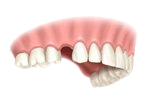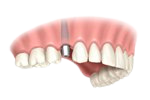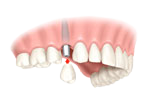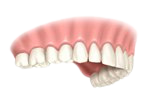Single Tooth Replacement:
Through dental implants are a great option for restoring multiple missing teeth, it’s also perfect solution if you are missing only one tooth. In that case, an implant in the jawbone surrounding the missing tooth is placed which serves as a replacement for a tooth root and an individual crown. This unique solution is referred to as a single-tooth implant crown.
Once in place, the implant crown looks, feels, and functions like your natural tooth. It’s cleaned and flossed just like your other teeth, and unlike bridges or other restorations, you don’t need special tools to clean around your new tooth. You will need to practice effective oral hygiene, however, and the friendly staff at Haines City Dental will be happy to talk to you about caring for your mouth.
Benefits of an all-ceramic crown on implant:
When both the tooth and root are damaged, the best permanent replacement is a dental implant in conjunction with a ceramic crown. This solution both looks and functions just like a natural tooth.
In this case, a so-called one-piece implant is used. This means that all components are installed as a single unit, resulting in immediately full functioning teeth, shorter treatment time and minimized pain. Immediately functioning teeth
Treatment:
This procedure normally includes four visits to the dentist. You should expect to be able to work the day after having the implant installed.
INSTALLING THE NEW TOOTH – STEP-BY-STEP
The course of treatment described here is one of several options available. Consult your dentist to find out what the best solution is for you, given your specific condition.
Fixed Bridge:
You have just had some crowns or fixed bridges cemented onto your teeth. They will replace your missing tooth structure or missing teeth very well and should give you years of service if you will observe the following suggestions:
CHEWING: Do not chew hard or sticky foods on the restorations for 24 hours from the time they are cemented. The cement must mature to have optimum strength.
CONTINUING CARE: Visit us at regular intervals as discussed with your doctor or hygienist. Often problems that are developing around restorations can be found at an early stage and corrected easily, while waiting for a longer time may require redoing the entire restoration. Inadequate return for examination is the most significant reason for protheses failure. We will contact you when it is time for your appointment.
PREVENTIVE PROCEDURES: Use the following preventive procedures that are checked:
SENSITIVITY: Don’t worry about mild sensitivity to hot or cold foods. It will disappear gradually over a few weeks.
AGGRESSIVE CHEWING: Do not chew ice or other very hard objects. Avoid chewing very sticky “hard tacky” candy because it can remove restorations.
PROBLEMS: If one or more of the following conditions occurs, please contact us to avoid further problems:
We have done our best to provide you with the finest quality oral restorations available today. However, as with a fine automobile or watch, only your continuing care and concern can assure optimum service longevity.
Dentures & Partial dentures
Patients normally look forward to the day when they receive their new dentures. They are happy about the prospect that former dental problems will soon be over. Then, the day arrive then the new dentures are inserted and they are frequently shocked that a new array of dental problems are just beginning. In order to receive the maximum service and satisfaction from new dentures, the patient must understand certain relevant and pertinent facts – whether they have previously worn dentures or not. Many misconceptions and erroneous ideas exist concerning the use and care of complete dentures.
Printed instructions have an important role in modern informed consent; and it is essential that the expectations of the patient and dentist are alike. It must be emphasized that both the dentist and the patient have an important role in the outcome of the complete denture service. The following patient instructions are based on the research and experience of many prosthodontists, over many years, and are intended to provide practical methots for mastering the use and care of new dentures.
Introduction:
The art and science of prosthetic dentistry had advanced rapidly during recent years and new techniques and materials have greatly improved our abillity to replace missing tissues with functional and natural looking artificial appliances or prostheses. However, it must be remembered from the outset that no prosthesis or artificaial substitue, regardless of how painstaikingly fabricated, will ever function as efficiently
as the original living tissues. Research has shown that the chewing efficiency of experienced denture patiens is, at best, less than twenty percent as efficient as the average chewing efficiency of patients with natural teeth.
Your mental atittude and adaptability are of utmost improtance to learning to use new dentures. Do not expect too much from them, especially at first. The dentist can only provide the denture treatment and then advise you. You must have the patience and perseverance to learn to use the dentures.
Just as learning to swim, or skate, or ski, or ride a bicycle can be traumatic experiences, so it may be learning to use new dentures. These are all physical skills that must be learned and no one is an expert in the beginning. The length of time required to learn to use dentures varies and depends on many factors such as age, general health, nuturtion, muscle tone, tissue condition, coordination, and mental attitude. Since no two patients are exactly alike, all patients cannot expect the same degree of skill or success in using dentures. However, it should be remembered that millions of other people have learned this skill and the odds are likely that you will too.
Please beware of relatives and friends who are denture wearers. Most dentures wearers consider themselves experts on the subject and are eager to give you advice based on their experience. Such advice can be inaccurate and harmful to you. Seek the advice of only one expert, your dentist, who has the training and experience to treat your specific problems.
Many denture patients would like to ignore the fact that they are, to a degree, handicapped. It is evident that a man with an artificial leg would have great difficulty becoming a professional football player. The denture patient must also learn to live with certain limitations. Since you will be wearing dentures from now on, it is no disgrace to use them in a manner that will help insure your ability to wear them in the future. Despite the limitations, your dentures will restore your appearance, speech and ability to chew – when you master their use.

1: Before the procedure
The dentist makes a first examination and takes one or more x-rays of the area to prepare for the procedure.

2: Installing the implant
The implant is installed. At this time, a temporary tooth is provided allows you eat & function like normal almost immediately.

3: Attaching the new crown
The final step is the placement of the permanent ceramic tooth. The new tooth is installed for life. No additional treatment is needed.

4: End result
You should expect the new tooth to fit and function just like a natural tooth. Do your usual dental hygiene to keep the tooth and gum around it clean and
